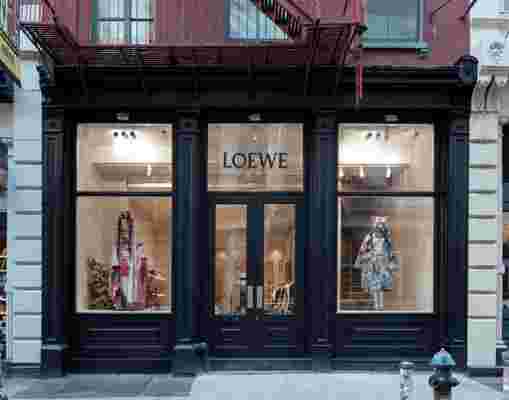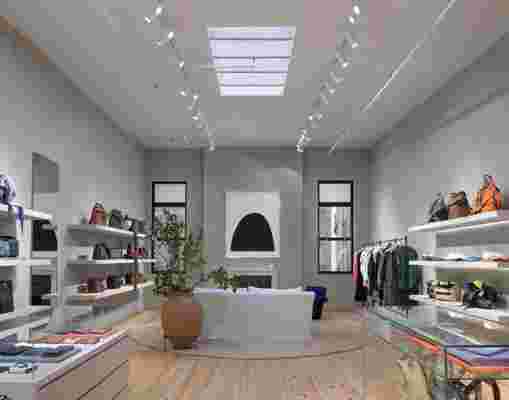At a time when many are questioning the validity of brick-and-mortar retail spaces, the notion of a destination store has become more important than ever for some fashion houses. Not only does an elevated boutique attract a sophisticated clientele—for whom the experience of shopping is nearly as important as the purchase itself—but it manifests as an environmental representation of a brand’s aesthetic and values. There is no doubt that Irish designer Jonathan Anderson understands this implicitly, judging by his meticulous approach to retail in the latest roll-out of stores for the LVMH-owned Spanish brand Loewe—a house he has transformed in four short years into one of the fashion world’s most influential names.
Dubbed Casa Loewe, each of the brand’s new flagships have been conceived as a showcase of Loewe’s participation in a cultural conversation that spans far wider than fashion. The first of these spaces was revealed in Madrid in 2016, Londoners got theirs this past spring, and New York’s Greene Street location opens this week. “There is something nice about SoHo that feels realistic and there is a kind of [homeyness] to it and a kind of romance,” Anderson tells AD, musing on his newest emporium that deserves the label “curated” in the truest sense of the word. By approaching each store like an art-filled living room, Anderson’s personal edit of modern and contemporary artworks from the Loewe Foundation finds harmonies with craft pieces acquired from makers who participate in the annual Loewe Craft Prize.

The new store is located on the ground level of an edifice characteristic of its SoHo neighborhood, which Anderson describes as “realistic, homey, and romantic.”
Though previous iterations have included backlit agate ceilings and dramatic staircases, the focal point of the Greene Street store is a curved bank of floor-to-ceiling threaded wooden columns inspired by a piece Anderson spotted at the Kettle’s Yard house and museum in Cambridge, England, home to the idiosyncratic collection of British and European avant-garde pieces accumulated by the late Jim and Helen Ede. “It’s one of my favorite houses, and I have been going there for a very long time; I think it’s one of the most dynamic collection in Britain,” he says. “As you go into the front door to the right, there is a cider press Ede bought or exchanged with someone in France, and above it he has a pair of crystal decanters and a blue painting by Miró that he was given while in Paris. I like the idea of repurposing something into a stand. There is a kind of Brancusi feeling to it.”
The ultimate resource for design industry professionals, brought to you by the editors of Architectural Digest

Though Anderson elicits no direct collaborations with decorator or architects for Loewe’s stores, the decision to strip back 79 Greene Street to gray stucco walls and its original oak floors allows for a warm, blank canvas for the international array of artists (some known, others obscure) whose creations he has placed throughout. “I really find something more interesting in buildings that are just for what they are. There is something less contrived about it,” he said, before citing Axel Vervoordt as both inspiration and supplier. “We’ve bought a lot of furniture from him,” comments Anderson. “He always has a really beautiful plaster finish. He has been able to exenterate spaces that already exist.”

With Vervoordt’s tables amongst the homier touches, a cornucopia of sculptures, paintings, photography, and ceramics can be found vying for attention with Loewe’s textural clothing and leather goods. Anderson insists his curation is instinctive, with no geographic rhyme or reason to the New York selection, which includes artists from New Zealand, South Africa, Germany, Japan, and Sri Lanka. “It’s really about the mood I’m in when designing a store. When I see the space, there is a vibe that feels right for it, or for the area,” he says. “Whatever is happening on that day when we do the edit of the works—it’s holistic.” Among those choices are names Anderson has championed previously, like that of Kate Newby, whose garland sculptures are strung from the ceiling, and the early-20th-century nudes of Lionel Wendt, which form a provocative dialogue with a hand-painted screen by Lisa Brice. Bigger, however, does not always mean better chez Loewe, with a vibrant yellow tea bowl by Takuro Kuwata demanding as much attention as a wall-size vintage photograph nearby. “It’s about the dialogue with the volumes,” says Anderson. “How do you take an Angus McBean picture and make it a precious object that could be big or small. A tea bowl or a ceramic can ground a room: It’s like a focal point or a full stop.”
